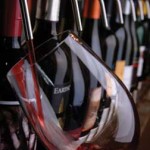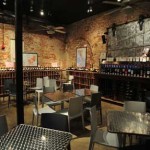Having a true affection for, and being a part time resident of the city of New Orleans, I have always planned for the New Orleans wine scene to be a part of this blog. In this and coming weeks I will be exploring the growing wine scene in New Orleans’ Warehouse District and Central Business District. In the past couple of years there has been a veritable explosion in wine retail options in downtown New Orleans, but this week I will be looking at the Wine Institute New Orleans (W.I.N.O.) the first of the wine shops in downtown New Orleans, which opened in April 2007.
In October 2006, Julie and I were doing wine tastings in Italy, focusing on Piedmont and Tuscany. We heard about a large enoteca or wine shop, perhaps the largest in all of Tuscany, the Enoteca Falorni, also know as Le Cantine di Greve in Chianti. Of course, we set out to find it.
Find it we did, and it was magnificent. The Enoteca Falorni is in the center of the Greve in Chianti region. It is below ground, in the cellar of a large, older building off one of the main roads. It is made of stone and brick with large support arches and sturdy wooden fixtures. The enoteca stocks nearly 1,000 wines for sale by the bottle, and you may get fabulous cheeses and salumi to go or to eat on the premises.
The Enoteca Falorni also featured something I had never seen before. Throughout the large space there were tasting stations, each featuring eight different wines available in the metric near-equivalent of one, two or four-ounce pours. Each tasting station was a machine, operated by a card one could purchase at a main service desk at the front of the store. You paid a certain amount and the card was debited each time you purchased a sample. More than 100 wines total, in many different price points, were available at different stations throughout the store. As Julie remembers it, my eyes got as round as pizza pies, and that was the last she saw of me for several hours!
Wine Institute New Orleans
Fast forward to the Warehouse District, New Orleans, Louisiana, just a few months later. The city was still reeling from the impact of Hurricane Katrina and the flooding that followed. The population of New Orleans, which according to the Census Bureau was approximately 485,000 people in 2000, had returned to only about 285,000 by mid-2007. The damage to homes, businesses and critical infrastructure remained severe. Yet in April 2007 the Warehouse District, like the rest of the city, was working hard to get off the mat. Many of the bars and restaurants were serving, galleries and shops were open, and Bryan Burkey opened W.I.N.O. on Tchoupitoulas Street.
Julie and I first returned to New Orleans post-Katrina in November 2005, just a couple months after the flooding. We had been coming back on a pretty regular basis since then and so became aware of the new wine shop in the neighborhood not very long after it opened.
W.I.N.O. in many ways reminds me of that fabulous enoteca in Greve in Chianti. W.I.N.O. is not small, but it does not have the size or the by-the-bottle selection of Enoteca Falorni. It does, however, have the same feel. W.I.N.O. is housed in an older Warehouse District building. It has a lot of brick and sturdy wood, and lighting suggestive of a cellar. Most significantly, it has those magical wine dispensing machines!
With 120 still wines available for tasting on the Enomatic wine dispenser, along with 16 selections of sparkling wine, W.I.N.O. allows enthusiasts at all levels to taste and enjoy a wide variety of wines from all over the world. The machines, like those I had seen in Italy, operate on a card. The machines use nitrogen gas to replace the wine as it is extracted from the bottle, preserving the wine for as long as four weeks, although owner Bryan Burkey tells me that a bottle rarely stays in the machine for more than a week. You may purchase pours of one, two or four ounces starting at $1.60 per ounce for some wines up to $20 per ounce for certain premium wines. You can also order selections of cheeses and charcuterie, and if you taste something you like and want to take some home, W.I.N.O. also sells its wines by the bottle. Bryan also hosts a free tasting every Thursday, and teaches a number of wine classes for differing levels of expertise throughout the year.
I do need to say a word or two about price as I have on occasion heard patrons comment that the per-ounce prices seem very high. What they mean is this. The standard bottle holds 750 milliliters of wine, which is a little more than 25 ounces. Multiply the per-ounce price by 25, and you get the approximate amount you would pay for the bottle of wine if you drank it entirely from the Enomatic machine. I have not conducted a comparison across multiple bottles at different price points so my estimate is very rough, but I would say the per-ounce cost of wine purchased through the Enomatic machine is twice the retail cost of the same bottle of wine.
The question to ask is, is that reasonable? I would say yes. W.I.N.O. is charging restaurant prices for wines by the glass, roughly double retail, but it also has a lot of additional overhead that a standard retail wine shop does not have. The distributor of the Enomatic machines tells me that depending on the style and features, the machines like those at W.I.N.O. can run from $7,000 to $12,000 each. W.I.N.O. has to amortize the cost of its 15 machines plus the ongoing costs of maintenance and supplies like the nitrogen gas; it has to provide clean glasses and staff has to bus and clean the seating areas. In short, it has to function like a restaurant or wine bar.
What Are You Really Paying For
In fact Bryan told me that W.I.N.O. had evolved into a wine bar and was not really a shop anymore. It is probably more accurate to say that it always really was more of a wine bar than a shop. For proof, one needs only spend a few hours there as Julie and I did several Fridays ago. There was a steady stream of customers, some locals and some clearly in town for conventions or in one case perhaps a bachelorette party. Most people had three or four tastes of an ounce or two, maybe a quarter of a bottle of wine each, and some did purchase a bottle for a later dinner or other event.
What W.I.N.O. provides is the democratization of the wine experience. In that quarter-bottle or so each of the patrons consumed that evening, they were tasting a number of different wines at different price points. Whether it was their intention or not, they were gaining experience, honing their palates, and getting at least an inkling of what the wide world of wine has to offer.
The patrons ran the gamut from the relatively sophisticated to the pure wine novice. That Friday evening there were colleagues gathering, awkward first dates and celebrations of major life events. And there was wine, lots of it, packaged and priced in a way that made it approachable regardless of the sophistication of one’s palate. And even as one who has more wine experience than average, there are still relatively few opportunities in life to drink an Opus One which may retail at $200 a bottle or be available in a restaurant for $500. While $20 an ounce is still a lot of money, it is a much more reasonable proposition, and one need not commit to the entire bottle.
Opus may not be your drink of choice, or perhaps you have had a little Opus in your life so do not feel the need to drop the $20 for a tasting, but W.I.N.O.’s other advantage is that there are so many different options available, and true quality wines at that.
On my last visit I tasted a pleasant Priorat from Spain, a well-known Oregon Pinot Noir and a truly awful (to my palate) but currently very popular (because, I would guess, it is so sweet) Washington state Riesling. I also had a sublime Maison Trimbach Riesling from Alsace, France and a gorgeous, floral Grand Cru Chablis from Burgundy, France (see my previous blog post about Alsatian Rieslings). Maison Trimbach is one of several producers that opted out of the wine classification system, choosing not to label its wine “Alsace Grand Cru” because it believed it had higher standards than those imposed by French wine law. The Chablis matched beautifully with a stinky, soft epoisses, also from Burgundy, that was one of the cheese selections on offer that evening. As I said, W.I.N.O. makes some truly wonderful wines available.
In March 2015 Bryan Burkey opened a new wine shop on St. Charles, just outside the Warehouse District. I have yet to visit, but Bryan tells me it is more of a traditional wine shop. It does not have the tasting machines, but will offer regular free tastings.
I noticed that Bryan had selected some great wines for the grand opening, including a Pinot Noir from Division Winemaking, a beautiful wine being produced by Tom and Kate Monroe at the Southeast Wine Collective, part of Portland, Oregon’s burgeoning urban wine scene.
Thanks, Bryan. This reinforces that Julie and I need to return to Portland to gather material for future posts!
As for the Enomatic wine dispensing system, the distributor tells me that over the past ten years they have equipped more than a thousand locations throughout the United States, including wine shops and wine bars of various sizes, grocery stores, hotels and others. If you hear of one in your area, I recommend you check it out. If the location has the technology and someone with the wine savvy of a Bryan Burkey, you may well be in for a treat.


Great information! An honest and wonderful resource for someone coming to NOLA!
Thank you so much for the article! We are glad you love the Enomatic wine experience!
Hmmm, perhaps you should bring an enomatic to Columbus!